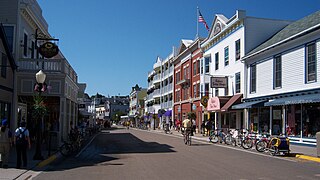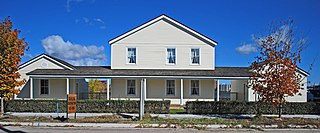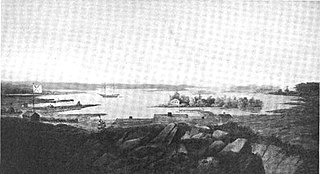
Mackinac Island is an island and resort area, covering 4.35 square miles (11.3 km2) in land area, in the U.S. state of Michigan. The name of the island in Odawa is Michilimackinac and "Mitchimakinak" in Ojibwemowin, meaning "Great Turtle". It is located in Lake Huron, at the eastern end of the Straits of Mackinac, between the state's Upper and Lower Peninsulas. The island was long home to an Odawa settlement and previous indigenous cultures before European colonization began in the 17th century. It was a strategic center of the fur trade around the Great Lakes. Based on a former trading post, Fort Mackinac was constructed on the island by the British during the American Revolutionary War. It was the site of two battles during the War of 1812 before the northern border was settled and the US gained this island in its territory.

Mackinac County is a county in the Upper Peninsula of the U.S. state of Michigan. As of the 2020 census, the population was 10,834. The county seat is St. Ignace. Formerly known as Michilimackinac County, in 1818 it was one of the first counties of the Michigan Territory, as it had long been a center of French and British colonial fur trading, a Catholic church and Protestant mission, and associated settlement.

Mackinac Island is a city in Mackinac County in the U.S. state of Michigan. As of the 2020 census, the city had a population of 583.

Fort Mackinac is a former British and American military outpost garrisoned from the late 18th century to the late 19th century in the city of Mackinac Island, Michigan, on Mackinac Island. The British built the fort during the American Revolutionary War to control the strategic Straits of Mackinac between Lake Michigan and Lake Huron, and by extension the fur trade on the Great Lakes. The British did not relinquish the fort until thirteen years after the end of the American Revolutionary War. Fort Mackinac later became the scene of two strategic battles for control of the Great Lakes during the War of 1812. During most of the 19th century, it served as an outpost of the United States Army. Closed in 1895, the fort has been adapted as a museum on the grounds of Mackinac Island State Park.

Hercules Louis Dousman was a fur trader and real-estate speculator who played a large role in the economic development of frontier Wisconsin. He is often called Wisconsin's first millionaire.

Mackinac Island State Park is a state park located on Mackinac Island in the U.S. state of Michigan. A Lake Huron island, it is near the Straits of Mackinac. The island park encompasses 1,800 acres (7.3 km2), which is approximately 80% of the island's total area. The park is also within the boundaries of the city of Mackinac Island and has permanent residents within its boundaries. M-185 circles the perimeter of the park as the only motorless highway in the state due to the island's ban of automobiles. The park is governed by the Michigan Department of Natural Resources and the Mackinac Island State Park Commission. On July 15, 2009, the park celebrated its 20 millionth visitor.

Ramsay Crooks was an American fur trader who immigrated to Canada from Greenock, Scotland. He was the father of American Civil War Colonel William Crooks who served in the 6th Minnesota Regiment. In 1803 Ramsay worked in a trading post on the Great Lakes. He helped W. Price Hunt to organize and lead an overland trip to Astoria in the Oregon Country for John Jacob Astor in 1809 through 1813, as a partner in the Pacific Fur Company. He became general manager of the American Fur Company in 1817 and was president of the company from 1834 to 1839. While traveling for the fur trade company he dealt with many Native American tribes. He married Abanokue, the daughter of an Ojibwa Chieftain. They had a daughter together, Hester Crooks. Abanokue died around 1825. Crooks then married Emilie Pratte and had nine children. He spent his final days in New York.
Historic Mill Creek, formerly known as Historic Mill Creek State Park and Historic Mill Creek Discovery Park, is a state park, nature preserve, and historic site in the United States state of Michigan. It is run by Mackinac State Historic Parks, the operating arm of the Mackinac Island State Park. 625 acres (2.5 km2) in size, the park is located 5 miles (8 km) southeast of Mackinaw City, Michigan on U.S. Highway 23.
Joseph Bailly was a fur trader and a member of an important French Canadian family that included his uncle, Charles-François Bailly de Messein.

Magdelaine La Framboise (1780–1846), born Marguerite-Magdelaine Marcot, was one of the most successful fur traders in the Northwest Territory of the United States, in the area of present-day western Michigan. Of mixed Odawa and French descent, she was fluent in the Odawa, French, English and Ojibwe languages of the region, and partnered with her husband. After he was murdered in 1806, she successfully managed her fur trade business for more than a decade, even against the competition of John Jacob Astor. After retiring from the trade, she built a fine home on Mackinac Island.

Robert Stuart was a Scottish-born, Canadian and American fur trader, best known as a member of the first European-American party to cross South Pass during an overland expedition from Fort Astoria to Saint Louis in 1811. He was a member of the North West Company (NWC) until recruited by John Jacob Astor to develop the new Pacific Fur Company, which was based at Fort Astoria, on the coast of present-day Oregon. Astor intended the venture to develop a continent-wide commercial empire in fur trading.

The Mission Church is a historic Congregational church located at the corner of Huron and Tuscott Streets on Mackinac Island, Michigan, United States. Built in 1829, it was the oldest surviving church in the state of Michigan. In 1971, the Mission Church was listed on the National Register of Historic Places.

The Mission House, on Mackinac Island, is a historic structure owned by the state of Michigan. Built in 1825, it is listed on the National Register of Historic Places and is operated as part of the Mackinac Island State Park. The Mission House is a wood-frame structure covered in clapboard siding and constructed in a U shape. The center section is three stories, and the flanking wings are two stories. The front facade has a single-story porch covering the entrance in the center.

The Astor Fur Warehouse is a historic fur warehouse located at Bolvin and Water Streets on St. Feriole Island in Prairie du Chien, Wisconsin. Jean Joseph Rolette, an agent of the American Fur Company, built the warehouse in 1828. The warehouse was used until the mid-19th century; it has since been incorporated into the Villa Louis museum. The building, now a National Historic Landmark, is the only known surviving fur trade warehouse in the upper Mississippi valley.
John Alexander Drew was a prominent American trader in the Mackinac area in the early 19th century; it is now considered within the boundaries of Michigan. He also was a politician, serving in the Michigan House of Representatives for the 1841 session.

Elmwood, also known as the Henry Rowe Schoolcraft House, the Schoolcraft House or the Indian Agency, is a frame house located at 435 East Water Street in Sault Ste. Marie, Michigan. It was designated a Michigan State Historic Site in 1956 and listed on the National Register of Historic Places in 1974.

The John Johnston House is a private house located at 415 Water Street in Sault Ste. Marie, Michigan. It was listed on the National Register of Historic Places in 1970 and designated a Michigan State Historic Site in 1958.

Fort Drummond, also known as Fort Colyer or Fort Collier, is a military fort located on the west end of Drummond Island on Whitney Bay, in the vicinity of De Tour Village, Michigan. It is the only known military and civilian site established by British forces on American soil following the War of 1812. It was listed on the National Register of Historic Places in 1969 and designated a Michigan State Historic Site in 1956.

Mission Point is located on the southeast side of Mackinac Island, Michigan. It is approximately 21 acres (8.5 ha) in size between Robinson's Folly and the jetty terminating near Franks Street. The Island has a history of documented European development beginning with French Jesuit missionaries landing at the point in 1634, less than two decades after the Pilgrims landed at Plymouth Rock on the East Coast of North America.

Frank Russel Rounds (1861-1945) was an American carpenter, He lived on Mackinac Island and became known for building the Round Island Lighthouse - one of the most photographed lighthouses in the world. He built many Mackinac buildings, including the Little Stone Church, the boardwalk and the Wawashkamo golf club.




















